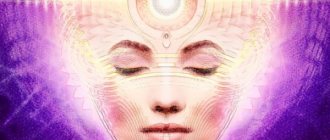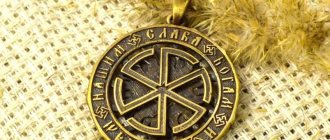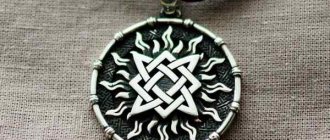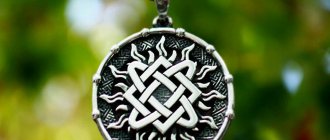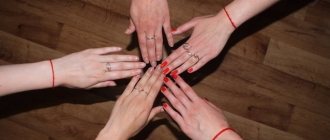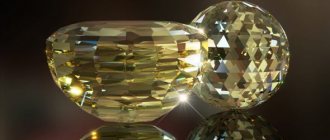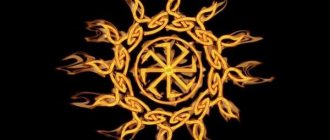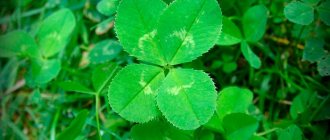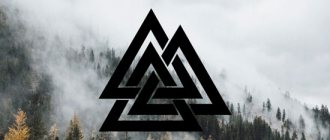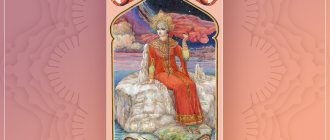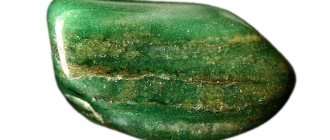Emergence
The history of the origin of the Black Sun tradition has been lost for centuries. Adherents of the ancient Russian religion - Rodnoverie - believe that this amulet was used more than one thousand years ago.
It is written in the Slavic Vedas in 988 AD. e. The Night of Svarog came into its own and black forces spread across the Earth, enslaving everything and everyone in their path. The Magi stood up to protect human souls: the situation forced them to reveal the secret of the “black sun” and other sacred talismans to a large circle of people. Since then, many magical secrets have been available to the common man.
This sacred dedication saved the Russian people. No matter how much dark forces tried to eradicate Slavic culture and enslave the souls of people, the people survived, protecting material and spiritual values.
The Black Sun amulet, although it became publicly available, was not particularly popular. Ordinary people were afraid of Navi, with whom he was associated. The invisible world is unknown, and therefore scary.
Nav
The mythology of the ancient Slavs tells about three sides of the surrounding world. They were called Yav, Nav and Prav.
- The first “dimension” - Reality - received a telling name - this is our obvious, material world, which can be felt by the senses.
- “Navya” was the name given to the world beyond the control and invisible of an ordinary person—the abode of spirits.
- There was also the concept of “Olympus”: Rule is the world where the supreme gods of the Slavs lived.
A simple person has encountered only reality throughout his life. The invisible, higher worlds were open only to a select few - those who possessed mystical knowledge. Only magicians and sorcerers could penetrate the worlds of Navi using the Black Sun talisman.
Continuing the theme of the worldview of the Slavs, according to
Using amulets
They tried to create the sun amulet on their own so that it would work better. The same principle is followed to this day. Natural materials for symbols served to strengthen the connection with nature and the divine world.
They used the signs of the sun, applying them to wood: oak, birch, pine, ash, beech. They were poured from gold for men, from silver - for women. Symbols carved on the metal of weapons or devices for cultivating fields gathered the entire clan of their owner under protection. Some were present to decorate household utensils and clothing, playing the role of guardians of comfort, love and family ties.
Amulets in the form of the sun and similar ones were common among all categories of the population. Slavic traditions included teaching knowledge about the nature and meaning of each of them. Correct and timely use of solar signs in amulets of a new type will help to comprehend the spirit of ancient civilization, discover new talents in oneself and understand the need to turn to the traditions of ancestors.
Meaning
The main meaning of the ancient Slavic symbol Black Sun is the connection with the mystical dimension, the world of spirits. Moreover, this implies a connection not only with deceased blood relatives, but, in general, with all generations of peoples who have ever lived on Earth.
One of the main conditions for using a symbol is honoring the culture and customs of your people.
A mercantile or disrespectful approach to the amulet can end extremely sadly: the human soul comes under attack. But following all the rules, on the contrary, inspires the soul, helps it open up and cleanses it of bad energy.
The cult of the sun and the solar gods of antiquity
Sun worship can be found among all nations.
In Ancient Egypt it was the god Ra on a solar chariot.
For the Slavs, Yarilo is a symbol of the sun, fertility and spring.
Among the Mayans and Aztecs, Tonatiuh is the god of the sun, life and death, the warrior of the spirit.
In Japan, Amaterasu (the sun goddess) is depicted as a woman and occupies a dominant place in the Japanese Shinto pantheon.
The Moabite and Ammonite deity mentioned in the Bible is Moloch. He was sacrificed as an adult and as an infant. For this he gave a reward.
In Persia, India, Iran there was a goddess Mithra. She was a symbol of wisdom and fertility. She gave protection.
In Ancient Rome, there was the god Apollo, the patron of creativity and science.
In Greece there was a god Helios. He was responsible for justice, introducing himself as the “all-seeing eye.”
Helios
Sun deity in Ancient Greece. He was depicted as an all-seeing eye or as a man with golden hair and a crown of sun rays. Few temples were built in his honor in Greece, but many statues were made. The most famous of them is the Colossus of Rhodes, considered one of the seven wonders of the world.
Five Helios stand out: 1. born from the nymph Acanto. 2. father of Kirka and Ieta. 3. son of Hyperion. 4. grandson of Nilus. 5. son of Zeus
According to Homer, Helios is the god of herds of cows and sheep. Every morning the animals rose into the sky, and in the evening they descended into the ocean while the god watched them, riding his chariot across the sky. Then he boarded the golden boat and returned to his palace. One day, Odysseus's companion killed the solar bull Helios. As punishment, Zeus crashed their ship with lightning. On July 20, a holiday dedicated to Zeus and Helios was held in Greek cities.
Apollo
He was the solar deity of the Greeks and Romans, the son of Leto and Zeus. He was also the patron of muses, creative people, a fortuneteller, a healer and the personification of canonical male beauty. The cult of Apollo is widespread and is reflected in statues, temples and paintings. We are accustomed to seeing in him the canon of beauty, and not the sun god. He became the personification of the sun only in late antiquity.
Ra - Egyptian sun god
His name means "Sun". According to one myth, the god Ra was born from an egg, according to another - he was a scarab beetle rolling the Sun. The pharaohs were considered the sons of the god Ra, his governors on Earth. Ra endowed his “sons” with wealth, fame, creativity and greatness.
The Egyptians explain the movement of the sun across the sky as follows: Ra traveled from the east in a solar chariot to illuminate the earth, then moved to Sectet to end the solar day and spend twelve hours in the afterlife. There he fought with evil demons and a giant serpent, and having defeated him, he returned again to illuminate the earth.
Amaterasu
Amaterasu (Omikam) is a solar goddess, the ancestor of the imperial family in Japan. She was born from drops of water flowing down Izanaki's eyes. She is worshiped as a symbol of the Sun, the goddess who introduced the technology of rice cultivation, silk production and gave people the loom. Amaterasu shrines are widespread throughout Japan.
Miter
Mithra is translated as friendship. Persian god of sunlight and harmony. His cult penetrated to Rome and partly to Greece. He guides the dead to the afterlife and helps the suffering. The symbols of Mithra are: an eagle soaring into the sky; Leo - courageous and strong; bull - justice. Interestingly, Mithra is not considered a sun god, since he was born from a stone and appeared before the rays of the sun.
Slavic gods
The Slavs had many solar gods. But among them there are three most important: Khors, Dazhdbog, Yarilo.
1 Khors is the Slavic god of the solar disk.
He was depicted on a horse or chariot, carrying the Sun across the sky. The name Khors is associated with the word round dance. Pancakes, honey, eggs and horseshoes were sacrificed to God. Solstice, Colard and Ognivets are dedicated to the horse. Attributes: The sun as a natural phenomenon; Horses, chariots;
2nd Dazhdbog - god of sunlight, eldest son of Svarog. God of fertility, sunshine.
This god was perceived by the Slavs as a guest who gives light, or as a messenger of the gods who gave people light and warmth. The objects with which the god was depicted were a shield, a spear or a staff, and less often a sword. The sign is a simple cross. This maintains balance. The Dazhdbog spell is a powerful protection for the owner and brings peace of mind. Sacrifices to God - honey, nuts, bird feathers.
Attributes:
Fire as a constituent element.
Horses, cows, dogs, white wolves, falcon, swan, goose are a symbol of animals.
3. Yarilo - the god of the spring sun, as well as fertility.
Shepherds turned to him for protection of their livestock, since Yarilo was considered the shepherd of Volcha. Yarilo was depicted as a young man with golden hair, a pointed beard, wearing a wreath or branches with young leaves. They offered pancakes, eggs, honey, flat cakes, grain, and porridge.
Attributes: Animal symbol - wolf or hare. The sign of God - Yarovik - an amulet in the shape of a swastika with four rays. It is used not only for personal protection, but also to protect homes, livestock and crops. It brings cheerfulness, happiness and love to its owner.
What does the mascot look like?
Its structure is based on the solar symbol of Kolovrat, personifying solar movement. Its deeper symbolism is the eternal cycle in the Universe, cyclicality, renewal of all things.
The ancient sorcerers-creators strengthened the power of the talisman with the power of three Kolovrat, giving each of the figures a deep meaning:
- Formation is the birth and development of everything new in the world;
- Being is the stage of sustainability, the preservation of what has been created;
- The passage symbolizes the end of any cycle, the finale of any path, after which a new round invariably begins.
The three Kolovrat, united into one sign, personify the Universe with its divine, natural canons.
Origin story
The symbol of the Slavs, the Solstice, is one of the most powerful symbols known to their ancestors. He was considered a conductor of life-giving solar energy. The sign connects Yarilo, Dazhdbog and Khors together, symbolizing their energy and power. In the past, the sun was considered a protector against all evil. The Solstice amulet was worn to protect against damage, the evil eye and bad wishes. Symbols associated with the daylight were depicted on all kinds of amulets, house walls, and personal items. They decorated clothes, embroidered on shirts and linen. The ritual solar sign was used in the design of religious objects.
Solar patterns have been known since antiquity
Visually, the Slavic image resembles Kolovrat, Kolyadnik, Ladinets. This is a round sign with 8 rays, externally similar to a luminary emitting life-giving energy. Grozovik and Gromovik differ from other solar symbols in their unique design of lines. The symbol was used to protect living things from dark forces. The Slavs believed that it helps to pass on the sacred knowledge accumulated by their ancestors to future generations.
Who is it suitable for and how to wear it
In ancient times, this talisman was worn only by a select few. People who have magical knowledge and abilities, who know how to use and manage them. The symbolism of the Black Sun, initially accessible only to dedicated priests, entered into the everyday life of ordinary people.
Important: this sign cannot be used as an accessory; its magical power must be used exclusively for its intended purpose.
Benefits for men
A man is inherently characterized by courage and fortitude; in one word - masculinity. But some all have shy traits, weak character or willpower.
The Black Sun amulet has powerful energy; such men need to wear it to replenish their masculine traits and develop a strong character.
In addition, the talisman gives healthy confidence, helps to find oneself in this world and realize one’s own importance.
Benefits for women
The symbol of the Black Sun means the beginning of beginnings, so such a talisman will help a pregnant woman or one who is just about to have a child.
The ancient Slavic sign will protect the expectant mother throughout pregnancy and will help develop the best character traits in the child.
